PAGE 59a – March 2007
H O T I D E A S F O R S M A L L R A I L R O A D S

This mid-month Scrapbook returns to the KISS principle which is one of the
watchwords of this site: Keeping It Simple! Recently a number of layouts requiring just
two turnouts have appeared in our e-mail. The amount of fun that some of our readers
can obtain from such simple means is impressive! I hope it’s also inspirational. Read on!
BOX STREET YARD — A CLASSIC WITH ONLY TWO SWITCHES (POINTS)

Jack Trollope’s small switching plan, Box Street Yard, has become a modern classic of small layout design. It’s been used as a basis for layouts all over the world, in part because it manages to provide a very flexible switching capability with a minimum of investment — two turnouts and a few lengths of flex track.
Jack, who lives in the Highlands of Scotland, originally designed the layout to fold up and fit in a box that was given him by a friend. For more details, see the article in our Micro Layout Design Gallery. We have also featured quite a few variations on Jack’s design, including railroads by Jeff Hartmann and John Bruce (both in California), Nick Palette (a German version!), Mike Bragg (in O scale), Daniel Schläfli, John Bruce (in England), “Versif”, Ken Scott and at least three variations from Jack himself — two in Scrapbook #54 and another in #42!
Anyone looking for a good, workable plan using simple ingredients would be hard pressed to find a better design than Box Street Yard. However, read on for still other suggestions!
THIS BOOKSHELF SWITCHER IS BUILT IN 1:19 SCALE!
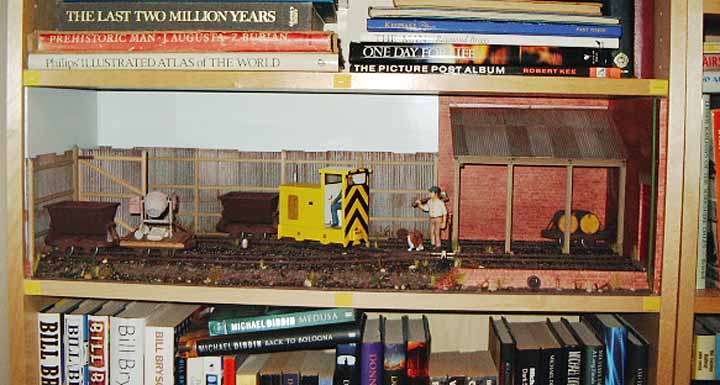
The two-turnout format provides an ideal playground for Large Scale stock on Baigent Yard by Bill Corser, from Oxfordshire, England. The 30x10in (75x25cm) railway is kept in a bookcase (above) and is built to 1:19 scale (16mm to the foot) running on O gauge track (32mm). When the layout is out of the bookcase, a fiddle yard can be added at the left side to increase operating flexibility and challenge.
This little two-footer represents a modern narrow-gauge construction railway assisting the Bowcester [pron. “bowster”] & Vayne canal-preservation society to restore the lock at Baigent’s Basin. “To secure their railway equipment they had a fenced works yard in one corner of what had once been Baigent’s works,” Bill explains. “The layout would therefore be called the Bowcester & Vayne Canal Preservation Society Baigent’s Basin Renovation Project Light Railway Works Yard, or B&VCPSBBRPLRWY for short.
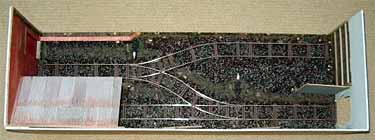 “The trackwork represents prototype portable track made by Hudsons, called Jubilee track, with pressed steel sleepers (crossties) and supplied in short panels able to be carried by two men. The model sleepers are pressed out of brass strip with in-built rail fixings that ensure the gauge is correct and are produced by Brian Clarke. Nine-inch lengths of code 100 rail are soldered to the sleepers to make panels of the right length. Brian also supplies parts for the turnouts, of which there are one right hand and one Y (wye).
“The trackwork represents prototype portable track made by Hudsons, called Jubilee track, with pressed steel sleepers (crossties) and supplied in short panels able to be carried by two men. The model sleepers are pressed out of brass strip with in-built rail fixings that ensure the gauge is correct and are produced by Brian Clarke. Nine-inch lengths of code 100 rail are soldered to the sleepers to make panels of the right length. Brian also supplies parts for the turnouts, of which there are one right hand and one Y (wye).
“The loco is a model of the Alan Keef class K12 diesel, made from plasticard and components, powered by a battery inside the engine compartment… There is still lots to do: more rubbish and gunge to scatter around the yard, and a few more people when I can get round to painting them. I also want to make a scale model of a porta-loo (port-a-john) of the type seen on most construction projects these days. Operation is also leisurely. The digital principle (Big Hand in the Sky) is used to operate the turnouts, couple and uncouple the stock, and operate the loco.”
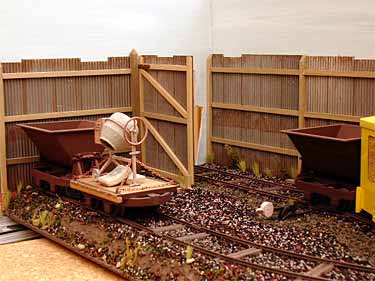
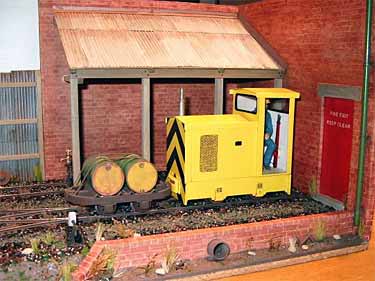
HERE’S A CRAMPED STATION WITH LOTS OF OPERATION
Maldon Market Hill station is built in very cramped quarters behind Maldon High Streeet, between the shops and the industrial buildings whose shipments keep the road in the black. Andrew Smith, who built the line, says that the engine shed and maintenance works for loco and stock is farther along the line (offstage), towards the junction where the line to the Quay diverges to the River Blackwater. All of this occurs in East Essex, in England.
Both goods (freight) and passenger trains call at the little station, and Andrew has provided some insight to those operations. Movements like these are typical of operating with two locomotives (a road engine and a station pilot) and explain why this type of two-switch track arrangement is a “tried and true” design.
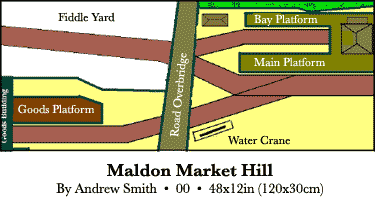
Goods trains (freight trains) consist of an 0-4-0 loco, two wagons or vans (freight cars), and a brake van (caboose). The station pilot is waiting in the bay platform when the train arrives at the main platform.
- The pilot removes the brake van from the rear of the train and takes it to the bay platform.
- The goods loco shoves the wagons into the industry yard. Any loaded wagons ready to ship are pulled out and shunted into the fiddle yard.
- The goods loco then places the new wagons at the industry loading facility, returns to the fiddle yard for the outgoing wagons, and returns with them to the main platform road.
- The pilot loco then removes the outgoing wagons from the loco and shunts them into the bay platform road, coupling to the brake van.
- The pilot moves to the crane track.
- The goods loco moves out, couples to the outgoing train, and leaves town.
- The pilot returns to the bay road to await the next train.
Passenger trains consist of a loco and two four-wheeled coaches. In this case, the pilot waits at the water crane as the passenger train pulls into the main platform road.
- After passengers are offloaded, the pilot couples to the rear of the train and pulls the coaches into the industry track.
- The road loco moves to the bay platform.
- Pilot loco returns the coaches to the main platform and retires back to the water crane track.
- Passenger loco returns to the main platform, couples to the coaches, and leaves town.
- Station pilot returns to the bay platform, ready for the next train.
Variations can be played with both goods and passenger consists. Two livestock vans can arrive on market day as a separate train, and must be shunted to the stock platform in the bay road. If the passenger loco is an 0-6-0, there won’t be room for the pilot to couple on from the crane road, so it will have to wait in the bay road and pull the coaches out to the fiddle yard to release the passenger loco. And so it goes, at a busy little station with minimal facilities!
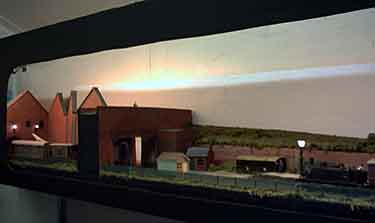
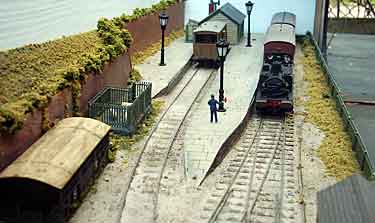
DUTCH PEAT LAYOUT INCLUDES A TURNTABLE
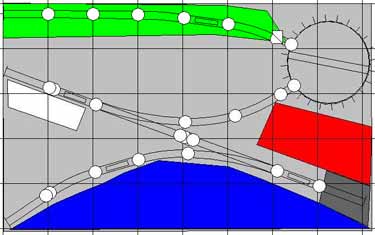
Using a record-player table as a baseboard, Marco Roepers, from Onstwedde, The Netherlands, has begun work on this HO scale 80x50cm (31x20in) layout. Called Veenderij Draaitafel (“peat-cutting record table”), the little pike depicts a peat-cutting company in a small harbour in the northeast part of the Netherlands. The track is being laid with Fleischmann Profi tracks, which have a relatively tight radius. Short cars will be used to bring peat to the factory and to carry the peat-litter to the “rest of the world” (represented by the green “fiddle” track). Although Marco is just beginning construction, he is already making changes to the plan, which uses two switches and a turntable to good effect.
A ‘CLASSIC TOUCH’ TO THE TYPICAL TWO-TURNOUT TRACKPLAN
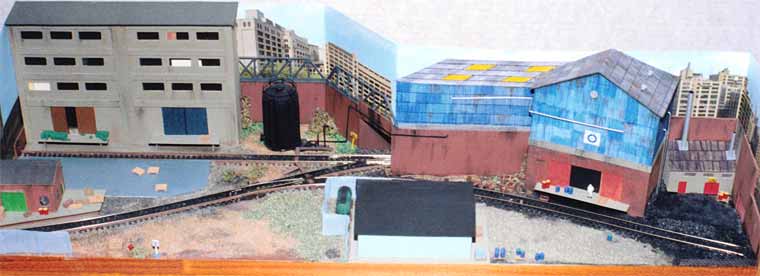
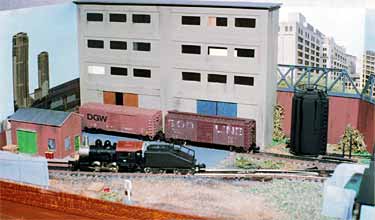
Published here for the first time in color (or “colour”), Shortside Yard was first presented in black-and-white in 1990 in the British magazine Scale Model Trains. Jordan Foster, from Cradley Heath, West Mids, England, built the 24x7in N scale railway and sent the photos to show that this simple two-points plan still works well. “It may not be historically accurate or rivet-countingly perfect, but it was fun to build and fun to operate, which at the end of the day is what this hobby is all about,” Jordan declares.
PLAN PERFORMS PERFECTLY FOR PALLET PRODUCTION
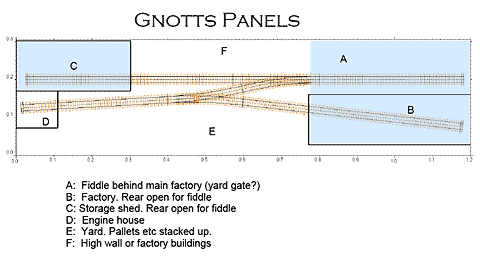
Martin Hogg, from Mansfield, England, is considering this same classic track formation for his industrial tram in Gn15 scale, Gnotts Panels. His not-to-scale diagram and notes reflect his thoughts about arranging rail traffic to suit the industrial process being modeled — in this case, the manufacture of wooden pallets and panels. According to Martin, the layout traffic will include:
- Rough cut timber in to be treated and turned into pallets and panels (from A to B)
- Pallets and panels moved from factory to storage shed (B to C)
- Finished items taken offscene (delivered) (C to A)
- Additional traffic could include scrap out, miscellaneous metal fittings, etc. in
- Also coal in to an engine shed where a steam engine powers the plant
- Also of course all the empties being moved around.
Scenery,” reports Martin, “will feature a yard hemmed in by the factory buildings, with stacks of pallets for the little locos to weave their way through.” For more about Martin’s modeling adventures, see his website. For a glimpse of another layout featuring pallet production, see Pete’s Pallets, also featured in the Micro Layout Design Gallery.
ROCKIN’ TO A DIFFERENT DRUMMER WITH TWO TURNOUTS
Since last we visited Heavy Traffic, in Scrapbook #57, a lot has been happening in preparation for a spring exhibition debut. HTR is an OO scale layout by Steve Grantham, from Bubwith, North Yorkshire U.K., and it makes a very different use of two turnouts as well as adding a sector plate to facilitate operations.
Steve reports, “Since you saw it last I have now installed all of the ground cover from concrete to assorted gravel and greenery. It has also gained a number of fences and the populace are slowly starting to appear. Signage for the structures has been made up on the Mac and printed but is still to be applied. Some weathering is in place but there is still a lot to do before it appears at the York exhibition in April.”
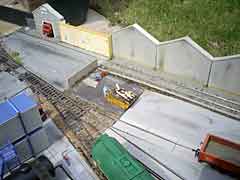
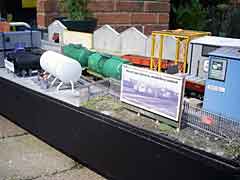
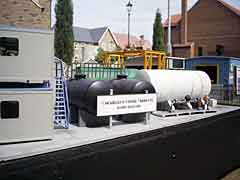
A TROPICAL TEASER FROM FRANCE


Fabrice Fayolle, from Amiens, France, has completed the open-air loco shed for his tropical sugar-cane railway in Oe/On30. The completed layout will measure 135x45cm (53x18in). For more information see Fabrice’s website. Meantime, enjoy his fine modeling!
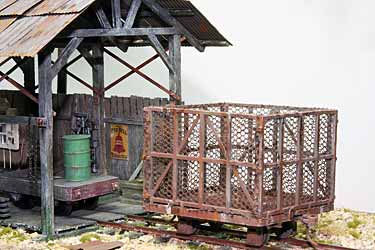
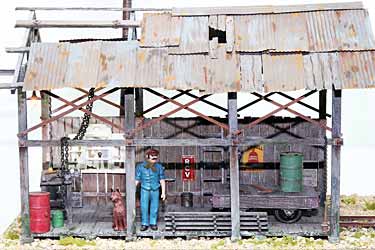
I N G L E N O O K S H A V E T W O T U R N O U T S , T O O !
An increasingly popular switching game that originated in Britain is the Inglenook line,
where two switches are used to form a fan of three sidings. Eight wagons/cars are distributed
on the sidings, and the objective is to organize them into a departing train of five cars —
marshalled in a preset sequence. Sounds easy, and isn’t! For details about the game, see
the Shunting Puzzles site. For examples of actual Inglenook layouts, keep on reading!
SCENERY HERE IS MADE OF PAPER

Martin Hogg’s four-foot OO Inglenook, Ball Street Sidings, has scenery made almost entirely of paper … mostly from the Internet, mixed with some Metcalfe models. Martin muses, “I’ve boarded up wondows, added some graffiti and pigeon poo. There’s still lots of muckying to do (including weathering of stock). I want to add a chain link fence to replace that brick wall at front and some kids playing football (soccer). I just need to stop playing with it long enough to get some things done!”
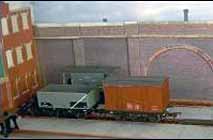
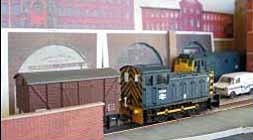
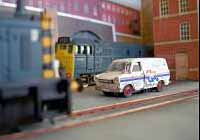
DOUBLE YOUR PLEASURE WITH THIS 2X INGLENOOK

Kenneth Rickman, who in real life is a locomotive engineer on the Norfolk Southern, designed this layout to include a pair of Inglenooks as well as a mainline track for future expansion. It’s a 64x9in HO standard gauge layout made with Atlas #4 turnouts and a 12.5-degree crossing. Motive power could be an Alco S1, a 44-tonner, or a small 0-6-0 tank loco. Forty-foot cars are required. The diagrams below illustrate how the two Inglenooks are interlaced.



As you might expect, I couldn’t resist this one! After squinting at it for awhile, I realized that one simple change could transform it into a competitive bombshell. Here it is: move the lower left crossover toward the center of the board, so that the left-hand inglenook fan can use that siding as its third spur … freeing up the top left track to be exclusively a drill track for the right-hand yard. Now both Inglenook yards are independent — and TWO players can simultaneously work at assembling their assigned consists! Imagine the titanic struggles that could ensue! It’s a whale of a lot of action for a four-foot board!

Kenneth is actually building a somewhat-larger home layout. He shared his design (above) and commented: “It’s an 8x1ft switching layout that incorporates an Inglenook as a yard in a small southern town. For the moment, the plan is to use this as a switching puzzle (can you get the train off the main and switch the various spots?), but it will eventually become part of a much larger layout. Since it’s meant as a portion of a larger system, I’m using code 70 rail and #6 turnouts throughout. I figure I can handle about 10 cars, plus a locomotive and a caboose at one time…
“One of the things I hope to do with this layout is to use it as a teaching tool for some of our new conductors, letting them try to figure out how to switch a train and being able to observe and teach, without the frustration of sitting on the engine asking what the heck they’re doing back there! We’ll see how well that works.”
BELGIAN SHOEBOX HOLDS AN INGLENOOK GAME
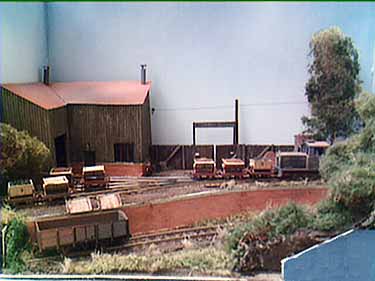
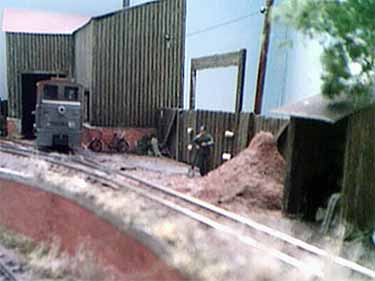
Laurent Hendschel, from Bruxelles (Brussels), Belgium, is building a delightful shoebox layout in H0 narrow gauge, incorporating an Inglenook game as part of the design. The Inglenook is H0e (9mm gauge), and the front track is H0m (12mm gauge). The shoebox measures 345x215mm (13.5×8.5in), and the Inglenook is stripped down to a 3-2-2 car configuration.
Laurent comments, “The layout is inspired by a real place — sand pits in the village where I was born (Bioul, Belgium), where sand was brought with narrow gauge trains to the “big” metre-gauge vicinal railway, and from there, to the even bigger standard gauge railway. The real site from which my layout is freelanced was called “Satersi” — from “Sable Terre Silex,” because they exploited aluminium sands, plastic earth and flint stone. I spent my childhood around there, and the line was in our backyard.” So this nostalgic little layout is named Satersi.
‘GOD’S WONDERFUL RAILWAY’ REMEMBERED AS AN INGLENOOK
Andy Young, from Darlington, England, is building this 80x20cm (32x8in) Great Western Railway layout as a birthday present for his father, a life-long GWR fan. Says Andy, “It is a basic Inglenook stripped down to 3,2,2. The main idea of the layout is a fun diorama rather than for maximum operating capability. It represents a small factory yard with a typical GWR pagoda halt.”
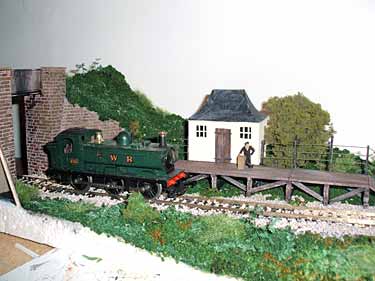
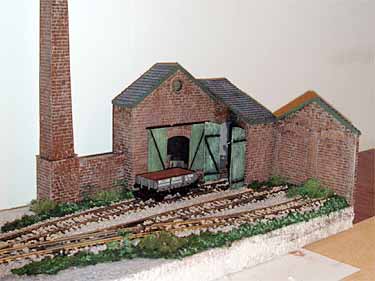
THE ‘ITALIAN JOB’ ADDS SOME ACTION
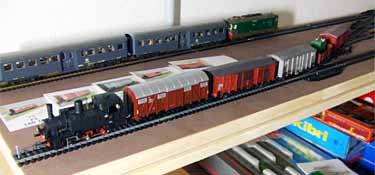
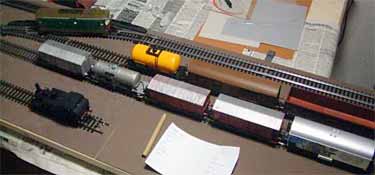
In Italy, Maurizio Melis is building a “test layout” in the form of an Inglenook with some extra features that complicate the switching problems. One idea is to declare the rear track a “main line” (but still the longest Inglenook spur). Periodically the main line must be cleared to allow a train to pass … a real headache for the switching crew! Maurizio credits this idea to Adrian Wymann’s excellent Shunting Puzzles site.
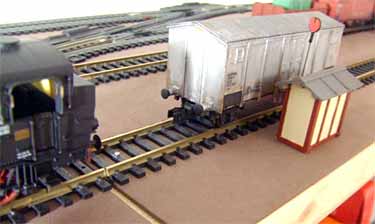
Maurizio has added another idea of his own, based on the little model (at right) of an Italian weighing station. Periodically, a car card will come up requiring a car to be weighed (on the lower right track) before being assembled into the departing train … and this too can require aspirin for the switching crew! You can see a track plan and learn more about this in-progress layout at Maurizio’s website.
CLASSIC BRITISH-OUTLINE INGLENOOK IN N

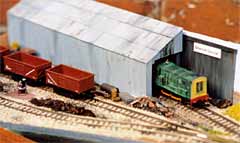
Jordan Foster sent along these photos of Oldbury Basin, which had the honor of being the first layout published in Issue #1 of Model Trains International magazine. It’s a classic Inglenook in N scale on a 24x6in baseboard. An article about the layout appears on the MTI website. This is the first time these photos have been published in color.
GERMAN SHOEBOX ADDS ANIMATION TO ITS INGLENOOK
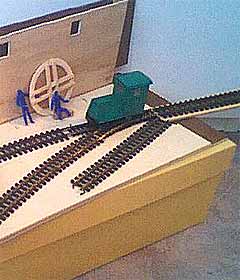
Rittigsmühle (Rittig’s Mill). a delightful German Inglenook, was introduced in Scrapbook #56a. Its revolving mill wheel was described in #57a. And now Alex Lehmann, from Mannheim, Germany, has sent some up-to-date photos of scenic progress on the O9 layout (1:45 scale on 9mm gauge). Rolling stock has been scratchbuilt by Alex, and he will be exhibiting this layout in the near future!
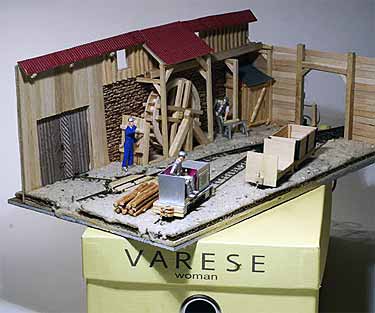
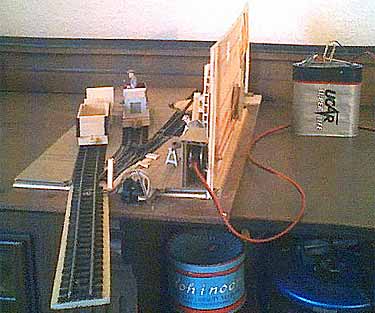
Leave a Reply